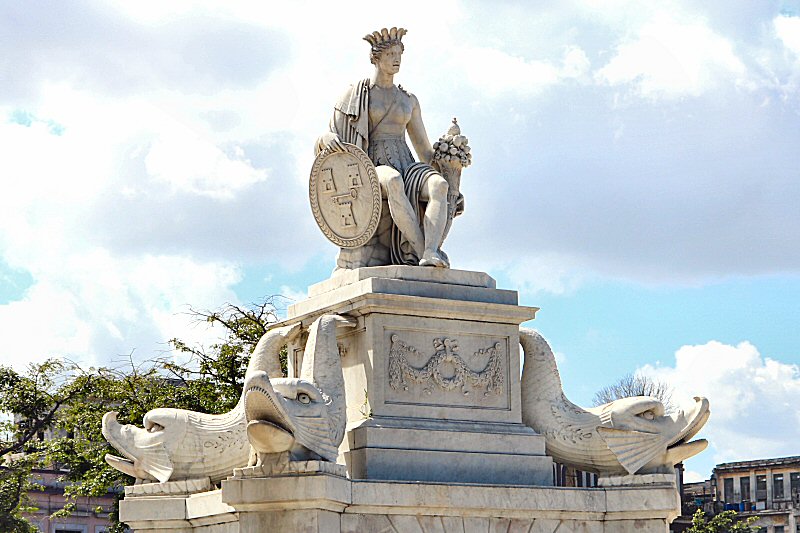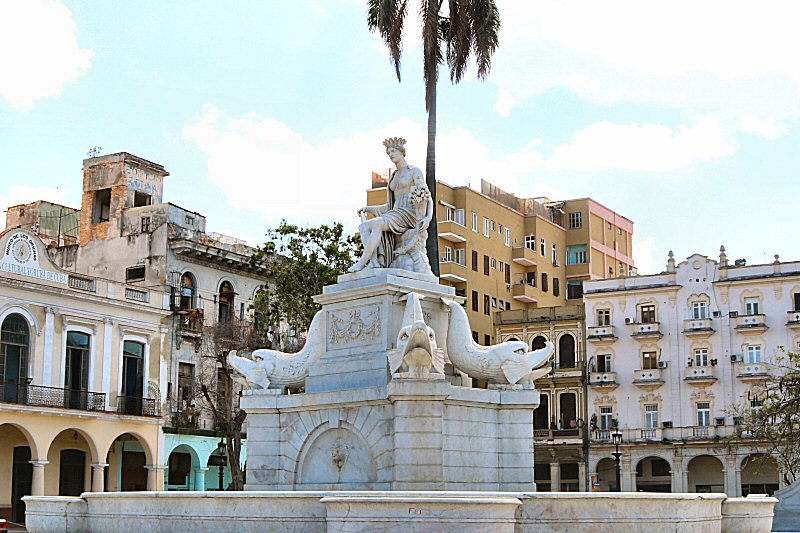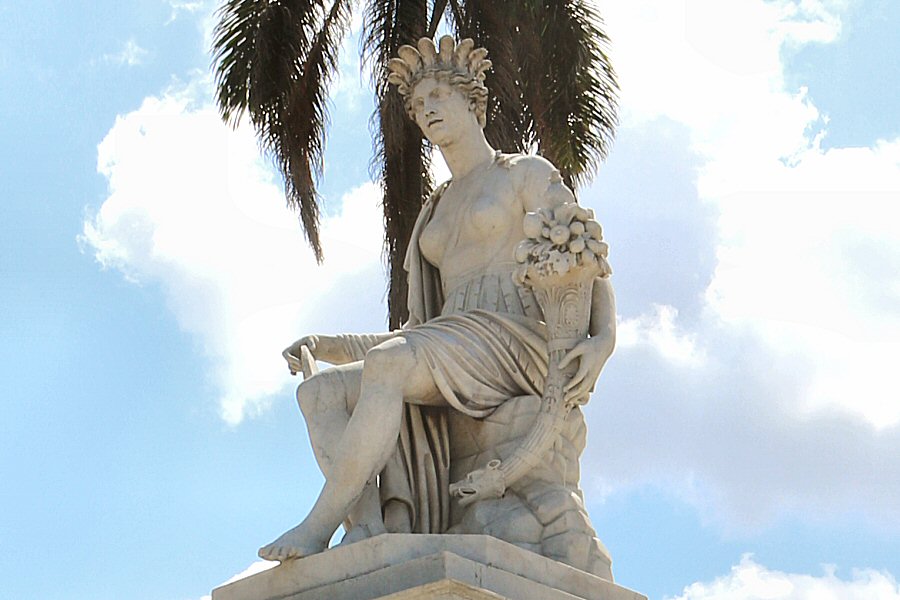
The Fuente de la India is located at the end of the Paseo de Martí, a few steps from the Avenida Máximo Gómez that is popularly known as Monte Street, approximately 100 meters south of the Capitolio.
THE LEGEND
The statue in the Fuente de la India
(Fountain of the Indian Woman) or Fuente de la Noble Habana
(Fountain of the Noble Havana), represents the image of the
mythical native Cuban woman, from whom the capitol of Cuba
took its name. She was the beautiful wife of the chieftain
(cacique) Habaguanex that was reigning in the area where the
Spanish colonizers set a foot on the island in one of the
voyages of Christopher Columbus.
According to the widespread legend, when the Spanish colonizers arrived in the northwestern part of the island in 1509, they had to flee from a strong windstorm, and they put in at a bay where they could careen their ships. When the captain noticed that the bay could protect the ships from the big waves of the ocean, he called it Puerto Carenas (Port of Careening). Later the Port of Havana arose from the Port of Carenas.
In one of those
mornings that followed the windstorm, the Spanish soldiers
went to a discovery trip on the island and they saw a very
beautiful native girl, sitting on a colossal rock. Her long
jet-black hairs were covering her bronze body like a cloak.
She had a shiny appearance, like a bronze statue, because
she had shortly bathed in the waterfall and had sat down on
the top of the rock to dry her hairs under the sun. She
watched the Spanish soldiers silently and then approached
them cautiously. When an officer asked the girl about her
name, the girl answered with dignity “Havana”. The girl
answered every question that the officer asked her about the
name of the place, her father’s name etc., with the same
word “Havana”. The soldiers were stunned by the serene and
beautiful native girl that replied their questions obviously
without any fear. When the girl made a circular gesture by
her hands, referencing to the spacious bay and the virgin
hill and uttered again “Havana”, the officer announced:
“from today onwards, this place will be called Havana”. Then
one of the soldiers that was an amateur painter, drew the
sketch of the beautiful girl on a rock and wrote below
“Havana”.
The Fuente de la India was brought
from Italy to Havana in 1837. It was erected at the end of
the Alameda de Extramuros (Extramural Mall; today Paseo de
Martí) in a place, where the statue of the King Carlos III
had been since 1803. The Fuente de la India, as well as the
Fuente de los Leones on Plaza de San Francisco were erected
by the initiative of Claudio Martínez de Pinillos y Ceballos,
the second Count of Villanueva. Both the fountains were
entrusted to the Italian sculptor Giuseppe Gaggini that
followed the designs prepared by the Spanish Colonel Don
Manuel Pastor in Cuba. Some contributions were made also by
the Italian architect Andrea Tagliafichi. In 1863 the city
council agreed to move the fountain to the Central Park. In
1875 it was relocated to the place that it currently
occupies, but it was looking towards the Campo de Marte. In
1928, when the old Campo de Marte was converted into the
Parque de la Fraternidad Americana, the fountain was given
the current position, without moving it from its place.
The base of the marble fountain is
in elliptical shape, its longest axis being 9 meters. The
2,1 meters high statue of the Noble Habana is placed on a
square marble pedestal, adorned with laurels and garlands.
The pedestal supports four big dolphins at each corner.
Water spouts from the mouth of the dolphins into the huge
shell-shaped basins. All the elements of the fountain are
made of white Carrera marble.
The native girl is represented
sitting semi-naked on a rock. She is looking to the east, as
if searching for something on the horizon. She has a crown
of feathers on her head. She carries a quiver full of arrows
on her left shoulder. Her right hand holds the upper end of
an oval shield that bears the coat of arms of Havana, carved
at its outer face. She holds a cornucopia of Amaltea
(horn of plenty) at her left hand.
In general, the cornucopia was considered a symbol of
endless wealth and abundance in the Greek mythology.
It is represented commonly as a large horn-shaped container
overflowing with produce, flowers or nuts.
In Greek mythology Amaltea
is a nymph that was also the nurse of the God Zeus. Zeus
broke the horn of a goat accidentally while he was playing,
so that the horn was transformed into a cornucopia. He gave
it to Amalthea, promising that it would provide her in
abundance, whatever she desired. Italian sculptor
Giuseppe Gaggini replaced European fruits in the cornucopia
by Cuban, crowned by a pineapple. There is a criticism about
the figure of the statue that it presents a typical profile
of a Greek woman; this seems so maybe because of the
presence of the cornucopia.
There is also a fantastic story
related with the statue. It is said that the night before
its inauguration, several trees and houses were collapsed
due to the strong wind. However, the cloth that wrapped the
statue, didn’t even move.
The Fuente de la India was the
object of the first photo taken in Havana. It was
photographed by the Italian Antonio Rezzonico in 1841, with
the intention of introducing it in New York.




